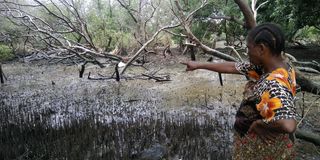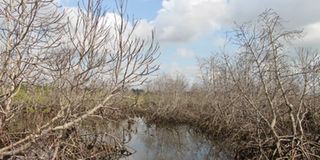Prime
Is Tazama oil spill to blame for the mangrove dieback in Dar?

Visual evidence: A Kijichi resident highlights the extent of mangrove die-off, believed to be caused by a recent oil spill. PHOTO | COURTESY
What you need to know:
- NEMC admits delayed response, promising an assessment to determine the extent of damage and potential legal action
Dar es Salaam. In an unusual environmental occurrence, mangroves have dried up in Kijichi, a coastal area along the Indian Ocean.
The area is just a few metres from Mwalimu Nyerere Kigamboni bridge, near the confluence of the Mzinga River and some adjacent regions along its banks.
The extent of the affected area remains unidentified, but investigations have revealed that many mangrove-rich areas along the river have suffered significant damage.
It is not only the mangroves that have dried up—some areas now appear barren, devoid of vegetation, aquatic creatures such as crabs, and birds, indicating environmental degradation.
Mangrove trees, which thrive in the meeting point of salt and fresh water, play a crucial role in preserving marine life breeding grounds, preventing coastal erosion, and mitigating the impact of ocean waves.
According to environmental expert Julius Enock Moshi, who also serves as an officer at the Vice President’s Office for Union and Environment, the loss of mangroves disrupts fish and aquatic breeding habitats, exacerbates coastal erosion, increases the risk of flooding, and allows larger ocean waves to reach inhabited areas, posing a danger to local communities.
Beyond these benefits, a 2020 study by the United Nations University (UNU) and the Institute for Environment and Human Security found that mangrove forests are more efficient at absorbing carbon dioxide than any other type of forest, mitigating climate change effects.

Recognising their importance, the government is developing a national mangrove management strategy, set to be launched in July this year.
What happened in Kijichi? Local residents attribute the drying of the mangroves to an oil spill that resulted from the rupture of the Tanzania-Zambia Oil Pipeline (Tazama) in early 2024.
Tazama authorities acknowledge the oil spill but deny responsibility for the mangrove die-off, arguing that they removed the spilt oil and that no scientific studies have linked the drying of mangroves to the spill.
Eyewitness accounts from the community Kijichi, located in the Temeke District, Dar es Salaam, sits at the convergence of the Mzinga River and an Indian Ocean channel.
Nearly a year after the oil spill incident, Ms Shakira Mohamed, a leader (mjumbe) of the Benki Club-Bukorani in the Dampo area, recalls the event vividly.
“The oil reached here,” she says, pointing to an area where the mangroves have dried, an estimated 50 metres from the river.
Ms Mohamed added that during the incident, people flocked to the area, using sponges to collect oil, which they later squeezed into containers.
“Some even rinsed themselves with clean water because the oil caused itching.
She strongly believes that the spill is responsible for the mangrove die-off”. “Fish died, birds disappeared, and even the crabs you see now were nowhere to be found,” she explained.
Ezeda Mwamnyani, another local resident, stated that the pipeline rupture occurred in Mbagala Kingugi (approximately three kilometres from the ocean) in April last year, leading to oil flowing into the Mzinga River.
Tazama later confirmed that the pipeline rupture occurred in Mbagala but did not specify the exact location.
“Mangroves began drying a few months after the oil spill.
The spill was so extensive that people collected oil in large containers,” Mwamnyani added.
Despite the environmental damage, residents claim they were not much affected, aside from water shortage and the strong odour of oil during the incident, which lasted for about four days.
Mr Adam Myamba, a farmer near the river, said that before the oil spill, mangrove trees rarely dried up.
“You might see one dry up, but it would take a long time before you see another. Now, it’s different,” he said.
While he acknowledged uncertainty over the cause, he suspects the oil spill played a role. “The drying started soon after the spill—why didn’t it happen before?” he questioned.
The impact extended beyond vegetation; residents who relied on Mzinga River water faced significant difficulties.
“Oil floats on water, making it impossible to use the river’s water,” Mr Myamba said.
Ms Amina Salum, another local leader, confirmed that the oil spill occurred in April last year. She lamented that no government official was seen investigating the incident, except for local leaders who warned residents against collecting the oil due to safety risks.
“No one reported health issues, but the mangrove drying started about a month after the oil disappeared,” she noted.
She also stated that she never witnessed any official cleanup efforts, aside from residents collecting oil in their own containers until it was depleted.

Tazama distances itself from the mangrove die-off. Mr Hija Masoud, Tazama’s health and environmental officer, emphasised that legal provisions require the company to conduct cleanup operations under the supervision of the National Environment Management Council (NEMC) whenever a spill occurs.
“We are responsible for cleanup, and we did it to ensure all spilt oil was removed. I cannot confirm whether the mangrove drying is linked to the spill,” Mr Masoud stated.
He insisted that multiple factors could contribute to the mangrove die-off and that further investigation was necessary. NEMC’s delayed response, TFS’s completed investigation Mr Clarance Nkwera, a marine geology expert and research officer at NEMC, admitted that the council learnt about the incident late, which delayed the identification of responsible parties.
“We only recently received information about this environmental damage. We will conduct an assessment to determine the extent of the damage, question locals, and decide whether legal action is necessary,” Mr Nkwera stated.
He explained that in cases of environmental destruction, NEMC assesses the damage, determines responsibility, and issues penalties based on the severity of the harm caused.
“The fine is determined by evaluating the ecological damage and estimating its financial cost.
The responsible party must also restore the affected area, including replanting and maintaining mangroves until they mature,” Mr Nkwera added.
Meanwhile, Selewin Regie, the Forest Conservation Officer for Temeke and Kigamboni under the Tanzania Forest Services (TFS), confirmed that an initial investigation had already been completed.
“Our role is to conduct preliminary investigations and forward the findings to regional and national authorities.
Other stakeholders are now handling the issue, and we will be informed of the final resolution,” Regie stated.
Further environmental concerns Mr Moshi reiterated mangroves’ vital role in coastal and marine ecosystems.
“Mangroves protect breeding grounds for fish, prevent coastal erosion, and reduce the impact of ocean waves,” he emphasised.

He warned that the drying of mangroves could hinder their natural regeneration, making it crucial to identify the cause and take action to prevent further damage.
“The factors causing this destruction may continue to affect other mangrove areas, so swift intervention is needed,” Mr Moshi said.
Tazama’s history of pipeline ruptures
This is not the first time Tazama has experienced pipeline ruptures. On May 17, 2023, Lusakatimes.com reported that Zambia lost over one million litres of fuel due to a pipeline rupture in Tanzania’s Mbeya region.
“The pipeline burst at Kilometre 839 near Mbeya University of Science and Technology (MUST) in Iyunga, Mbeya, spilling approximately one million litres of low-sulphur gasoil (LSG),” the report stated.
The rupture occurred on May 15, 2023, when a contractor working for the Tanzania Rural and Urban Roads Agency (TARURA) accidentally damaged the pipeline during road construction.
Notably, the Tazama pipeline is jointly owned by the governments of Zambia (67 percent) and Tanzania (33 percent).





